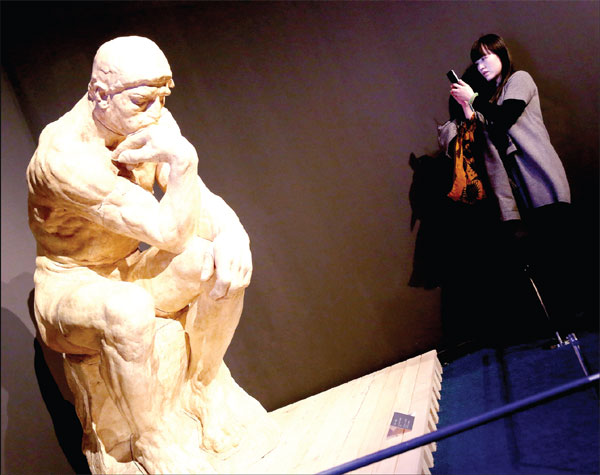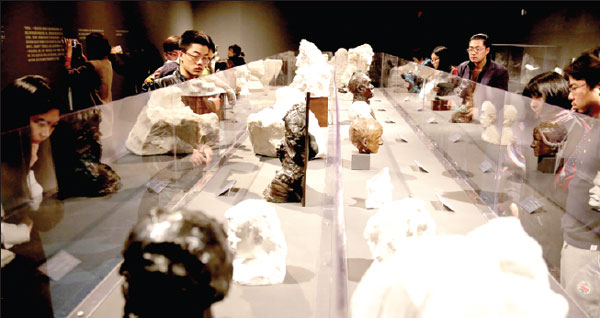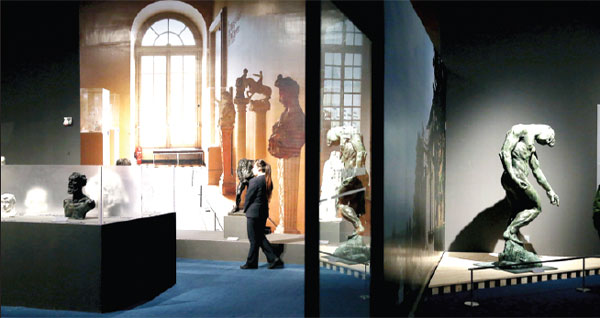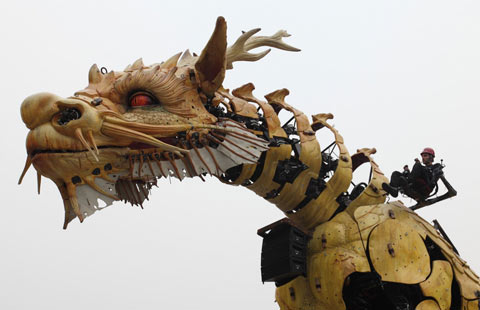Rethinking Rodin
Updated: 2014-12-02 07:13
By Xu Fan(China Daily)
|
|||||||||||
The National Museum of China celebrates France's muse of modern sculpture in a long-running retrospective, Xu Fan reports.
French sculptor Auguste Rodin, a legend in European art history, now has his largest exhibition ever in China.
On Saturday, the first weekend day since the retrospective show of Rodin's lifelong creations opened to the public on Nov 28, visitors flocked to the National Museum of China despite the haze and long lines outside the country's largest museum.
|
The Thinker is one of the highlights of French sculptor Auguste Rodin's exhibition in Beijing. Photos by Jiang Dong / China Daily |
|
The show displays 139 classic works created by the sculptor. |
|
The exhibition chronicles the creative and influential life of Rodin. |
The exhibition charges one of the most expensive ticket fees in the free-to-enter museum's history of special shows: 50 yuan ($8.13) per person. Most of the museum's ongoing exhibitions, covering a wide range from oil paintings to sculptures, are free.
"It's worth it. After all, it's a rare chance to get such a close view of the master's works," says Wang Mei, a 23-year-old art college graduate working in Beijing.
The show, co-organized by the Rodin Museum in Paris and the National Museum of China, displays 139 classic works created by the progenitor of modern sculpture.
Near the entrance of the exhibition room, the nearly 2-meter-tall bronze statue of the famed The Thinker captures the attention of nearly everyone who passes.
Most of the visitors squat down to read the introduction and use their smartphones to take photos of the sculpture.
The Thinker, depicted as a nude pondering male, first came to Beijing 21 years ago.
Its display in the National Art Museum of China in 1993 got a rapturous response from capital art lovers, which impressed Catherine Chevillot, director of the Rodin Museum. The chief curator of the exhibition reveals that Rodin was attracted by Chinese culture and had a big collection of Chinese artworks.
"If he were still alive, he would be very glad to come here, surrounded by the Chinese art treasures displayed by the National Museum of China," she said at the launching ceremony on Nov 27, according to the Shanghai-based Oriental Morning Post.
The exhibition comprises four parts, chronicling the creative and influential life of Rodin (1840-1917) by displaying his works in sets mimicking the artist's residence and studio.
The most celebrated work of Rodin, showcased in the center of the exhibition room, is The Gates of Hell, inspired by Italian writer Dante's epic poem The Divine Comedy. The Thinker was originally a figure of this monumental sculptural group work.
Initially a commission for a proposed museum in Paris that Rodin planned to finish in five years, the bronze sculpture took the artist 37 years to create, with more than 200 figures, until his death. The museum was never built, but the work becomes Rodin's most ambitious endeavor.
Other classic works, including The Age of Bronze and The Burghers of Calais, are also showcased in the Beijing show. Moreover, 61 sketches for his gypsum sculptures are on display, which allow viewers to see the artist's conceiving and creative process.
Because the gypsum productions are easily damaged during voyages, they rarely leave France - so this is a precious opportunity to see them, according to the museum.
"Rodin is a household name in China and has influenced several generations of Chinese artists, including me," says Chen Lyusheng, deputy director of the National Museum of China.
The Rodin show is a grand finale for a series of art and cultural events celebrating the 50th anniversary of Sino-French diplomatic relations, established on Jan 27, 1964. The exhibition will continue through March 22.
Contact the writer at xufan@chinadaily.com.cn
(China Daily 12/02/2014 page19)
Today's Top News
Chinese consumers' online choices proliferate
CPC sends out inspectors in new round of anti-graft checks
Swiss voters reject gold, immigration proposals
Sarkozy wins French UMP party leadership
Ireland pushes EU drive against smoking
One-child allowances continue with second birth
Editorial: Get HKSAR back on track
Women still outnumbered in top jobs
Hot Topics
Lunar probe , China growth forecasts, Emission rules get tougher, China seen through 'colored lens', International board,
Editor's Picks

|

|

|
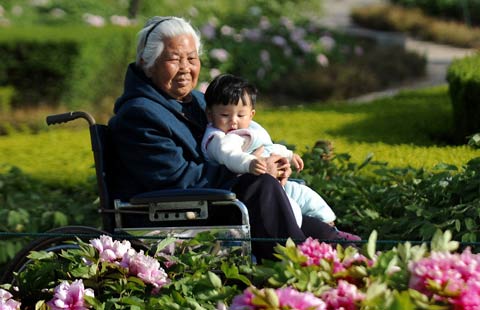
|

|

|
